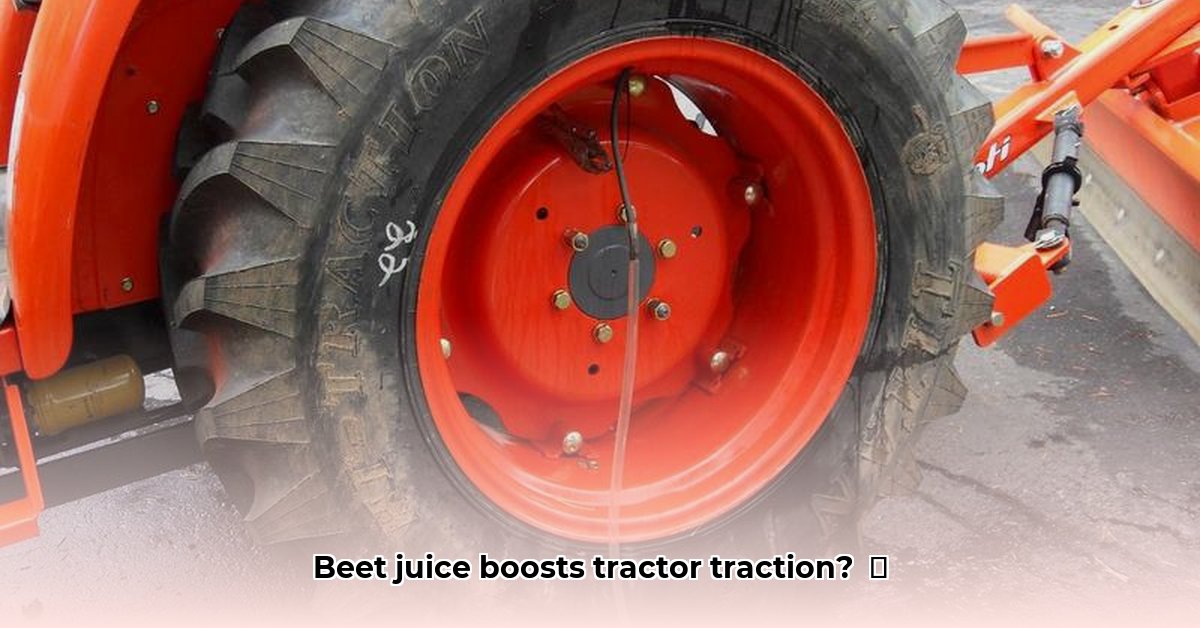
Beet Juice as Tractor Tire Ballast: A Sustainable Alternative?
Farmers constantly seek ways to improve efficiency and minimize environmental impact. Maintaining optimal tractor traction, especially in challenging field conditions, is crucial. Traditional ballasting methods often utilize calcium chloride, a corrosive and environmentally unfriendly substance. This article explores beet juice as a more sustainable alternative for improving tractor tire traction. Is it a viable option for your farm? Let's investigate. For more information on tractor tire sizes, check out this helpful resource: 8x16 Tractor Tires.
The Importance of Proper Tire Weight
Adequate tire weight, or ballasting, is essential for preventing wheel slippage and maximizing fuel efficiency. Insufficient weight leads to increased tire wear, soil compaction, and wasted fuel. Heavy fluids provide even weight distribution, enhancing traction significantly. However, many conventional heavy fluids pose environmental and safety concerns, highlighting the need for greener solutions. What is the environmental cost of using traditional ballasts? This is a question that needs thorough consideration.
Beet Juice: A Greener Ballast Solution?
Beet juice, a byproduct of sugar beet processing, emerges as a potential sustainable ballast. Its biodegradability and non-toxicity offer significant environmental advantages over traditional options. But, are these benefits outweighed by practical limitations?
Comparing Beet Juice to Other Ballast Options
The following table compares beet juice to other commonly used liquid ballasts. We've included a simple scoring system (Low = 1, Moderate = 2, High = 3) to aid comparison.
| Feature | Beet Juice | Water | Antifreeze (Propylene Glycol) | Calcium Chloride |
|---|---|---|---|---|
| Environmental Impact | 1 | 1 | 2 | 2 |
| Cost | 2 | 1 | 2 | 1 |
| Performance | 2 | 1 | 3 | 3 |
| Safety | 1 | 1 | 2 | 2 |
| Freeze Resistance | 1 | 1 | 3 | 3 |
Note: This data reflects general trends; actual performance can vary based on specific conditions and product formulations.
A Step-by-Step Guide to Using Beet Juice as Ballast
Adding beet juice to tractor tires is a straightforward process, requiring careful attention to safety procedures:
- Deflate Tires: Completely deflate the tires before proceeding.
- Remove Valve Core: Remove the valve core to enable fluid inflow.
- Fill Tires: Carefully fill the tires with beet juice using an appropriate pump, avoiding spillage.
- Replace Valve Core: Reinsert the valve core once the desired fill level is reached.
- Re-inflate Tires: Inflate the tires to the manufacturer's specified pressure, as indicated in your tractor's manual.
Caution: Always consult your tractor's manual for specific instructions and pressure recommendations. Incorrect inflation can damage tires.
Addressing Challenges and Research Gaps
While beet juice offers promising ecological benefits, challenges remain. Its higher initial cost compared to traditional options necessitates careful economic evaluation. Further research is needed to fully understand its performance in various climates, particularly during freezing temperatures. Long-term effects on tire materials also require investigation. Dr. Anya Sharma, Agricultural Engineer at the University of California, Davis, emphasizes the need for "rigorous field testing across diverse climatic conditions to validate beet juice's efficacy as a sustainable ballast." Moreover, regional availability is a critical consideration. Farms located far from beet processing facilities may face logistical hurdles.
The Future of Sustainable Tractor Ballast
Beet juice represents a significant step towards environmentally responsible farming. Continued research and development will be vital to refining its application and addressing existing limitations. Collaboration between researchers, manufacturers, and farmers is essential to promote the adoption of sustainable ballasting practices. The future of sustainable agriculture relies on such innovative solutions.
Choosing Sustainable Liquid Ballast: A Practical Guide
Key Takeaways:
- Sustainable liquid ballasts offer environmental and economic advantages over traditional options.
- Beet juice stands out as a promising, biodegradable alternative, although costs and availability need to be considered.
- Careful evaluation of climate, budget, and local regulations is essential when choosing a ballast solution.
Choosing the appropriate liquid ballast involves a careful assessment of cost, environmental impact, and performance requirements. This section provides a framework for making an informed decision.
Evaluating Your Needs
Before finalizing a ballast choice, consider your specific farming context. Factors such as climate (especially freezing temperatures), budget constraints, and regional regulations will significantly influence your decision. For instance, water, a readily available and inexpensive option, is unsuitable in regions with harsh winters.
Sustainable Ballast Options: A Comparative Overview
The following table summarizes various sustainable ballast options, providing a comparative analysis:
| Ballast Type | Pros | Cons |
|---|---|---|
| Beet Juice | Biodegradable, non-toxic, reduces environmental impact. | Higher cost, availability may be limited, performance in extreme cold needs research. |
| Water (with Additives) | Inexpensive, readily available. | Limited freeze resistance, additives may have environmental consequences. |
| Other Bio-based Options | Potential for future sustainable solutions. | Currently limited availability and require further research and development. |
Practical Steps for Implementing Liquid Ballast
Irrespective of the chosen ballast, follow these steps for optimal results:
- Thorough Cleaning: Clean the inside of the tires thoroughly to eliminate debris.
- Gradual Filling: Gradually add the ballast, carefully monitoring tire pressure and sidewall deflection.
- Regular Checks: Regularly check ballast levels and address leaks immediately.
- Eco-Friendly Disposal: Dispose of used ballast responsibly according to local regulations.
Conclusion
Choosing sustainable liquid ballast requires a holistic approach that balances environmental considerations, economic viability, and operational efficiency. By carefully weighing these factors, farmers can make informed decisions that promote both productivity and environmental stewardship. The adoption of sustainable practices is not merely a trend; it is essential for the long-term health of our planet and the agricultural sector.